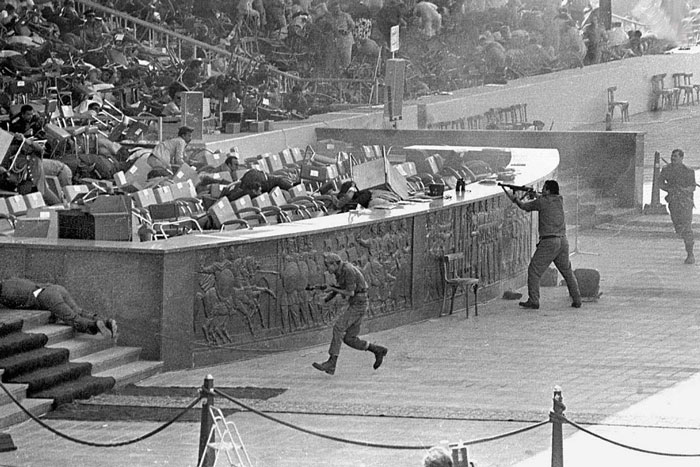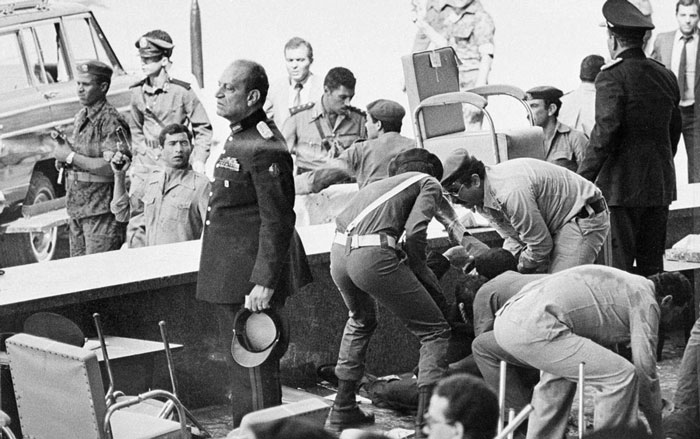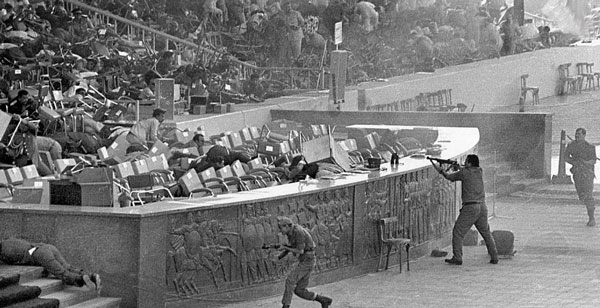Extremists assassinate Egyptian President Anwar Sadat in Cairo (1981).

The assassins’ bullets ended the life of Anwar Sadat — a man who earned a reputation for making bold decisions in foreign affairs. The reputation was based in large part on his decision in 1977 to journey to the camp of Egypt’s foe, Israel, to make peace.
President Sadat was the first Arab leader in history to recognize the state of Israel since its creation in 1948. In September 1978, he met with Israeli Prime Minister Menachem Begin in the United States, where they negotiated a peace accord and, in 1979, a peace treaty.
For their achievement, the leaders were awarded a joint Nobel Peace Prize.
In the Arab world, however, President Sadat’s efforts were not so highly acclaimed. The Arab states boycotted Egypt for breaking ranks and negotiating a separate treaty with Israel.
During a victory parade held in Cairo on October 6, 1981, to commemorate the 8th anniversary of Egypt’s crossing of the Suez Canal, President Sadat was protected by 4 layers of security and 8 bodyguards. The army parade should have been safe due to ammunition-seizure rules.
As Egyptian Air Force Mirage jets flew overhead, distracting the crowd, Egyptian Army soldiers and troop trucks towing artillery paraded by. But one of the truck carried the assassins by Lieutenant Khalid Islambouli.
As it passed the tribune, Islambouli forced the driver at gunpoint to stop. The assassination squad dismounted and Islambouli approached Sadat with three hand grenades concealed under his helmet.
President Sadat stood to receive his salute. Anwar’s nephew Talaat El Sadat later said: “The president thought the killers were part of the show when they approached the stands firing, so he stood saluting them”.
Islambouli threw all 3 grenades at Sadat. Only one exploded but fell short for its intended purpose. More assassins rose from the truck and indiscriminately fired AK-47 assault rifles into the stands until they had exhausted their ammunition, then attempted to flee.
When the people saw Sadat was hit and fell to the ground, they threw chairs around him to shield him from the hail of bullets.
Egyptian soldiers tend to the wounded after the assassination attack on the reviewing platform that killed Egyptian President Anwar Sadat.

The attack lasted about 2 minutes. Sadat and 11 others were killed outright or suffered fatal wounds. Security forces were momentarily stunned but reacted within 45 seconds.
One of the assassins was killed. Three others were injured and arrested. Sadat was airlifted to a military hospital, where 11 doctors operated on him. He died nearly 2 hours after.
Sadat’s death was attributed to “violent nervous shock and internal bleeding in the chest cavity, where the left lung and major blood vessels below it were torn”.
Eleven others were killed in the attack, including the Cuban ambassador, an Omani general, a Coptic Orthodox bishop and Samir Helmy, the head of Egypt’s Central Auditing Agency (CAA).
In addition, 28 others were wounded, including Vice President Hosni Mubarak, Irish Defense Minister James Tully, and four US military liaison officers.
The assassination was undertaken by members of the Egyptian Islamic Jihad. A fatwā approving the assassination had been obtained from Omar Abdel-Rahman, a cleric later convicted in the US for his role in the 1993 World Trade Center bombing.
Islambouli and the other assassins were tried, found guilty, sentenced to death, and executed by firing squad in 1982.

